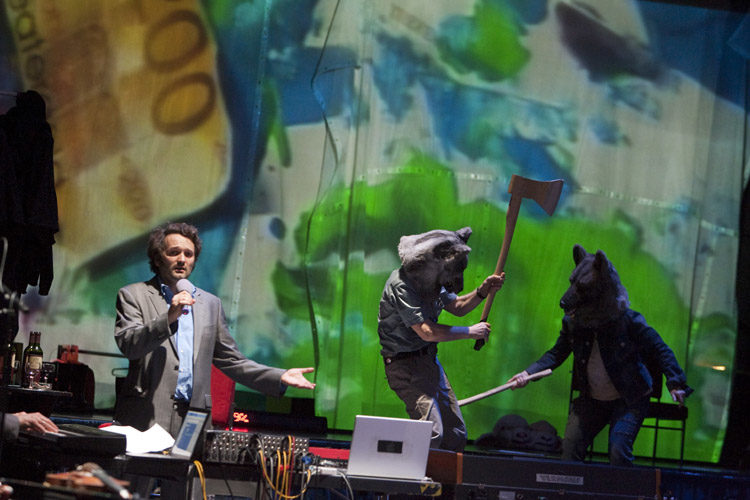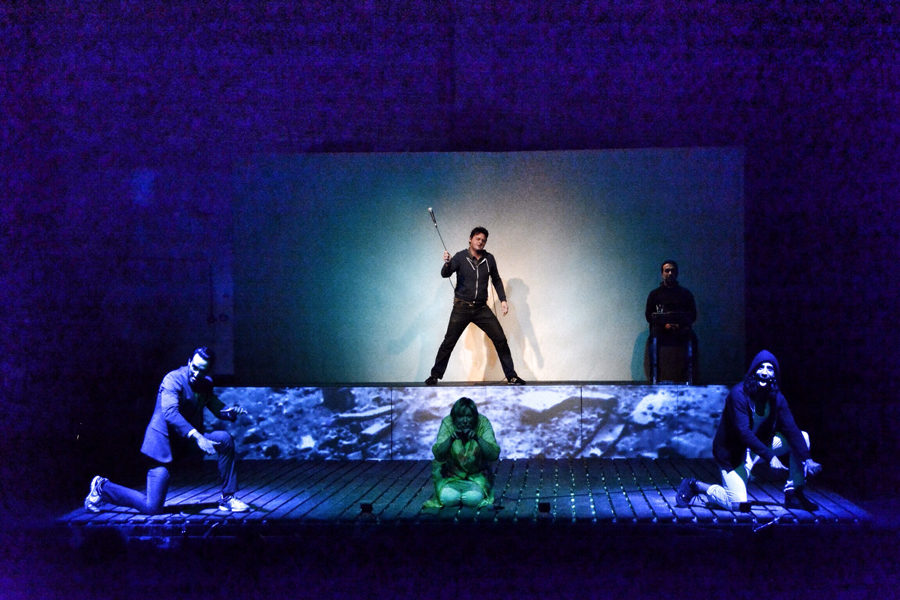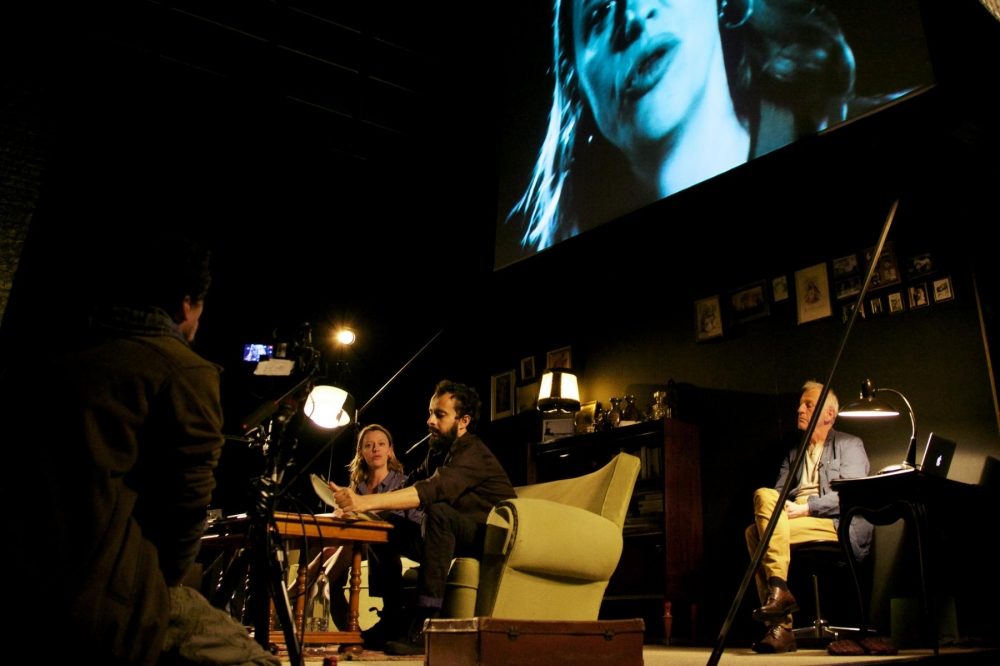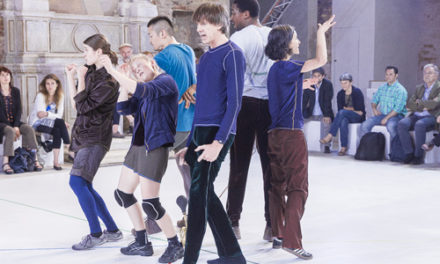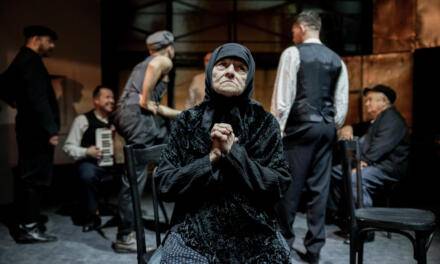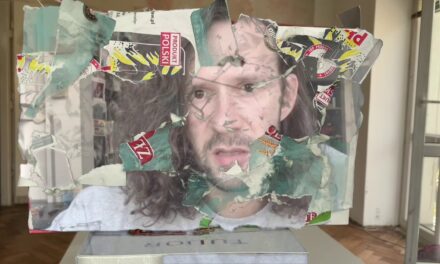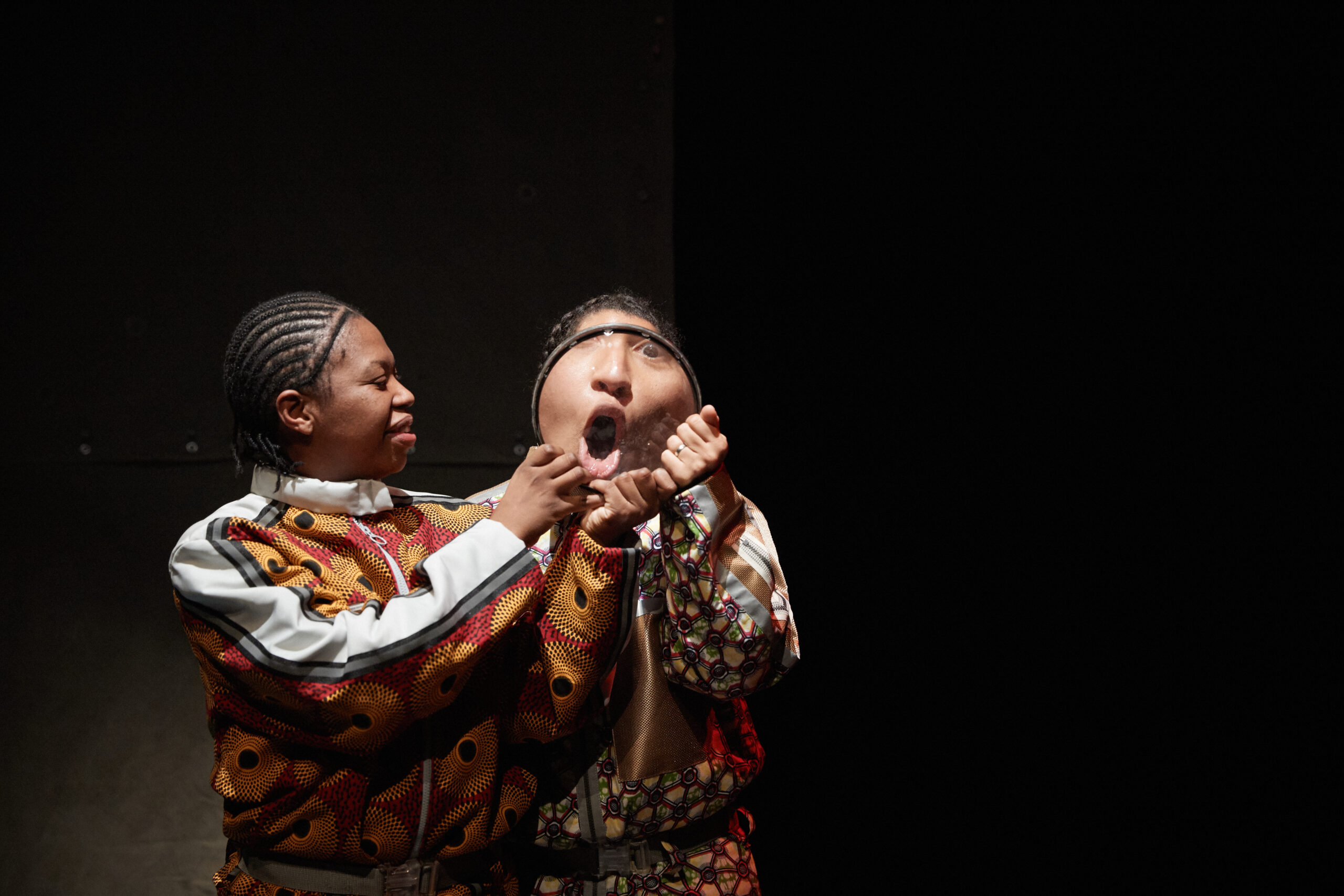From the ‘crisis play’ to the ‘memorial play’ to the ‘Syria play,’ current affairs are doing well in theatre. And yet this is not a matter of course for a medium that likes to invoke its slowness with regard to the flow of information that washes over us daily. But perhaps today, Kristof Van Baarle argues, we have a greater need for stories than for information.
It was impossible to avoid this spring: the ‘Syria play’ conquered the theatre. Various makers dealt in a variety of ways with the current issue of the Syria fighters. The press and the audience looked with heightened attention at the way in which these artists translated their vision to the stage. Responding to mediagenic subjects won’t do makers any harm, and these same media are happy to pick up these shows. Suddenly the subject of art’s crisis of legitimacy is again secondary in light of a so-called demonstrable social relevance. Nevertheless, ‘Theatre-makers eagerly translate topical themes to the stage,’ according to VRT newsreader Annelies Van Herck … Of course, this attention compels a certain skepticism. Are journalists giving up their critical reflection and are they turning to the theatre out of despair? Or do they find it amusing to watch the way in which the arts grapple with this subject? Or are the makers, whether consciously or not, being recuperated in a commercial logic, which reduces to entertainment the painful decision of young people and the violence that accompanies it? From an optimistic angle, the sold-out theaters and the media attention could be read as a form of hope that is based on the theatre. Hope for insight and hope for theatre as a common space for reflection and – if possible – catharsis.
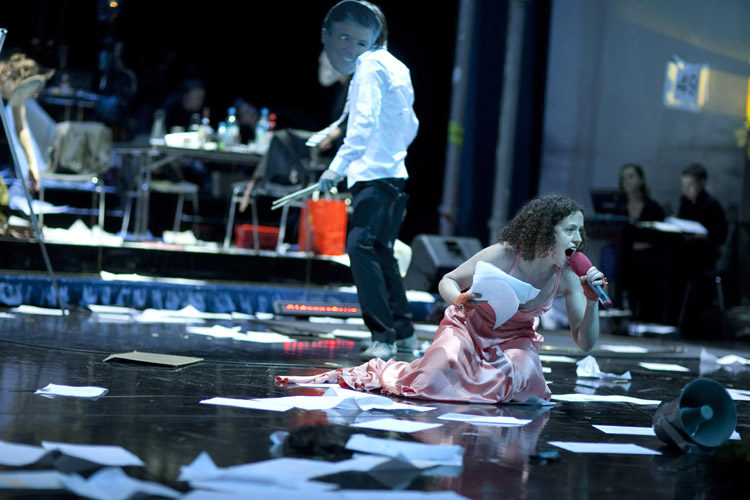
Efriede Jelinek’s Die Kontrakte des Kaufmanns. Directed by Nicolas Stemann. Thalia Theater Hamburg (2009) Photo credit David Baltzer/bildbuehne.de.
Theatre as a space for truth and insight, and as a place of community: two parameters that we can use to look at the relation between current affairs and theatre. In order to be topical ourselves we will take the Syria plays as an example, but we could equally have discussed the ‘crisis plays’ in the wake of 2008 (Hebzucht by Braakland/ZheBilding; Die Kontrakte des Kaufmanns by Elfriede Jelinek and Nicholas Stemann) or the ‘memorial plays’ around World War I (Memento Park by Thomas Bellinck, Gavrilo Princip by De Warme Winkel). The relation between theatre and current affairs is not obvious for a medium that likes to invoke slowness and time for reflection. In parallel with the longing for a space that does not move along with the daily flow of information, there is an age-old drive in the theatre to react to those current events precisely and to research the underlying trends, major themes and deeper motifs. When we look at the current state of the world – with wars in the Middle East and Ukraine, a genocide in Central Africa, growing inequality and tens of thousands of refugees in the Mediterranean – the urge to dwell on certain matters is understandable, on both the makers’ and the spectators’ side. We should be able to read the interest in the Syria plays as a critique on mainstream, bitty journalism, but also as a charge against the political sphere, which fails to offer a solid answer to this situation. Most news items evaporate in banality, but some gnaw away and ask for more than two minutes of dramatic footage and the edited opinions of experts. Phenomena such as the Syria fighters appear to fundamentally affect and confuse our Western society. A blow to the Eurocentric ego, a slap in the face of concerned parents and friends who ‘did not raise their children that way.’
In search therefore of a community with which to share that malaise. A Community is a primal characteristic of Western theatre, which developed in the Greek polis as a ritual moment of contemplation on social themes and a reflection on what it means to be human in this age and context. The audience collectively engages the confrontation with tragic stories, in the hope of being purified. The debate still rages about the tragedy of the Syria fighters. In Europe, the debate is polarized around various communities: the white, Western society, on the one hand; the Muslim community, on the other; and more importantly, the multicultural community that is at once a reality and a desire of many on a local and global level. The success of the Syria plays lurks in part in the longing for shared contemplation. Citizens feel that this is a social problem. The question is whether we are consequently also addressed via the theatrical representation as a society and encouraged to devise an answer to this … In order to compare the average media attention and its theatrical counterpart, we can go back to the difference between ‘story’ and ‘information’ made by German cultural philosopher Walter Benjamin. For him, information is only about superficial facts and short-sighted statements which do not lead to more profound causes or ideas. ‘The value of information does not survive the moment in which it was new’, according to Benjamin.[1] The story, on the other hand, has a long (oral) tradition of bringing people together, without giving conclusive answers to the questions that it raises. The story incites deeper reflection and touches a sensitive chord. Listening to a story together means momentarily sharing the paradox of existence.
If we interpret this correctly, information in this sense is anything but community-stimulating: the current news reporting rather seeks polarization and sensationalism without itself assuming any responsibility. When an audience subsequently chooses to come together in a theatre, to listen to a story about themes that were presented earlier in a divisive and fragmented manner on television, in the newspapers or on Facebook, it is perhaps (unconsciously) looking for something more. The consumer of news clearly feels the need to come out of his isolation and to share his traumatic experiences. That hunger explains the success of the Syria plays. The atmosphere in the theatre during SINCOLLECTIEF’s Reizen Jihad (2015) was, for instance, not unlike a recovered community that collectively recognizes itself in what was taking place on stage. The show revolves around Kersje, a young Flemish convert who has left for Syria, told from the perspective of her environment that is trying to understood her act of hope/despair, that has in part made it possible (the smooth recruiter who runs the travel agency Reizen Jihad), or with which it is familiar in another form (Flemish collaboration during World War II). Reizen Jihad does not go far enough in its quest for us to call it a story à la Benjamin, despite its attempt to approach the phenomenon from different perspectives, and therefore without judgment. The opinions and emotions that are assembled in this story do not differ so much from the voices that recur in most media (or at least in the better correspondence columns). The narrative of Reizen Jihad offers a doubling of a part of reality, but that mirror does not offer deeper insight into the issue. That this play brings together people – remarkably enough also a less ‘traditional’ theatre audience – and ensures that they relate to the characters is its trump card and achievement, but the result remains a community that is too fleeting, based, it is true, on recognition, but not on structural insight.
In Valley of Saints (2015), a show that offers less opportunity for communality but digs deeper in the complexity of the material, Michaël Bijnens and Aurelie Di Marino try to sketch a bigger picture and to lay bare the system. The play dissects in concise and precise dialogues the underlying geopolitics and (long-brewing) clash of civilizations that set off the bomb in the Middle East. Two archetypes – the rich Western investor and the worked-up Islamic fundamentalist – literally face one another in a similar rising conflict. Bijnens’ text offers a thorough analysis that places the phenomenon of the Syria fighters within a broader geopolitical conflict in which guilt and innocence are no longer pure categories. It is the type of interpretation that you hope to see offered just as clearly in the news or in a report. The quest for insight and understanding – theatre as a locus of truth – is what compels Valley of Saints. It is an exposition of the complexity of social phenomena that at the same time provides an explanation for and insight into the motivation of the young European fighters. And yet something is lacking. The stories which Benjamin discusses in his essay ‘The Storyteller’ explore experiences and knowledge that cannot fully be grasped by reason. They appeal to a new level of understanding that is more intuitive and that resonates with our ungraspable humanity. ‘The psychological connection of the events is not forced on the reader. It is left up to him to interpret things the way he understands them, and thus the narrative achieves an amplitude that information lacks.’[2] Therefore, the truth, according to Walter Benjamin, is not an absolute fact; it is a flash of insight that only occurs when something is both revealed and concealed. It is what Romeo Castellucci once called a ‘veiled truth.’ If something is exposed down to the bone, then it remains an external collection of facts – ‘information’ – that does not invite us to engage in a personal relation. Bijnens and Di Marino certainly do not lapse into pure ‘information’, but their vision and discourse are so conclusive that they leave little to the imagination. And it is precisely the imagination that creates an intimate relation with the work and ensures a feeling of connection among spectators, players, and the artwork. Thus it gradually becomes clear that striving after community and striving after truth are not unrelated. The emphasis can be on one of them, but it is the balance that propels a play towards both the heart and the head.
The art of storytelling is also central in Milo Rau’s The Civil Wars (2014), the first part of his European trilogy. The initial purpose of this play was research conducted into the Syria fighters, which led the Swiss playwright to visit France and Belgium, countries with relatively large numbers of fighters. In the end, The Civil Wars became a collage of the four actors’ autobiographies. The lives of Sara De Bosschere, Sébastien Foucault, Johan Leysen and Karim Bel Kacem are all marked by the loss of a guiding father figure. In turn they each bear witness to this fact, clearly and unsentimentally. The show opens and closes with a story about a father who featches his son from Syria. This sheds a different light on the life stories of the actors. The intimacy of the actors’ personal and often painful stories about their youth, jointly emphasized by the projection of a close-up in real time of the face of the narrators and the cozy living-room setting in which they are seated, involves the spectator in an intelligent and yet direct manner. The distance between storyteller, story and listener becomes very small. Rau brings together archetype and individual by letting his actors tell personal stories that transcend the subjective. The why of everything that they have experienced is not always clear for them either. But the unfolding of the various stories is ordered in such a way by Rau that parallel phases emerge. A shared process of loss resonates throughout their testimony, a process which can be extended to a general feeling of malaise in Western society. The end of the big narratives that now turns out to be hyperindividualism, preached by economists and politicians, has led to the dismantling of social networks and makes interpretation almost impossible. This state of being lost and powerless is not something we experience only with regard to the issue of the Syria fighters, but also with regard to, say, the migration issue, the swing to the right in politics, the growing inequality between rich and poor, the wars taking place far from our home, etc. And yet the storytellers are not desperate. They each have found a modus vivendi to deal with the moral decay. Therein perhaps lurks this play’s genuine tour de force. Individual insights from personal stories indicate a shared answer to the shared problems of a community.
The audience of The Civil Wars rallies around a ‘narrated truth’ that only emerges through and in the play. It is not the factual or absolute truth, but a vision on current events, coupled to bigger social and philosophical questions. A nice role is reserved here for the theatre, and a task for critics and writers. The essential question of the art critic, wrote Walter Benjamin, is ‘whether the work’s shining truth content is due to its subject matter or whether the survival of the subject matter is due to the truth content.’[3] The truth of a work may not emerge immediately, certainly not when the subject is still fully developing, as is the case with these current-affairs plays. Who knows how we will look back in the future on the various Syria plays? That is an assignment for the future, when the dust of history has settled. In the meantime, we must continue watching and listening to the stories that art brings us. Watching the paradox together, and failing to understand it together.
Kristof van Baarle is working at Ghent University on a doctorate on posthumanism in the performing arts. He acts as a dramaturge for Kris Verdonck – A Two Dogs Company.
Published with the kind permission of Etcetera
[1] Walter Benjamin, ‘The Storyteller’, from: Illuminations, translated by Harry Zohn, Schocken Books, New York, 2007, p. 90.
[2] Op.cit. p. 89.
[3] Op. cit., p. 5.
This post was written by the author in their personal capacity.The opinions expressed in this article are the author’s own and do not reflect the view of The Theatre Times, their staff or collaborators.
This post was written by Kristof Van Baarle.
The views expressed here belong to the author and do not necessarily reflect our views and opinions.

